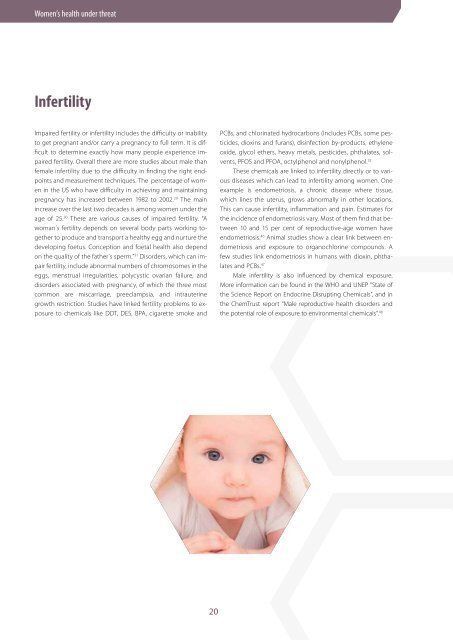Women and Chemicals
1ToENNR
1ToENNR
You also want an ePaper? Increase the reach of your titles
YUMPU automatically turns print PDFs into web optimized ePapers that Google loves.
<strong>Women</strong>’s health under threat<br />
Infertility<br />
Impaired fertility or infertility includes the difficulty or inability<br />
to get pregnant <strong>and</strong>/or carry a pregnancy to full term. It is difficult<br />
to determine exactly how many people experience impaired<br />
fertility. Overall there are more studies about male than<br />
female infertility due to the difficulty in finding the right endpoints<br />
<strong>and</strong> measurement techniques. The percentage of women<br />
in the US who have difficulty in achieving <strong>and</strong> maintaining<br />
pregnancy has increased between 1982 to 2002. 29 The main<br />
increase over the last two decades is among women under the<br />
age of 25. 30 There are various causes of impaired fertility. “A<br />
woman´s fertility depends on several body parts working together<br />
to produce <strong>and</strong> transport a healthy egg <strong>and</strong> nurture the<br />
developing foetus. Conception <strong>and</strong> foetal health also depend<br />
on the quality of the father´s sperm.” 31 Disorders, which can impair<br />
fertility, include abnormal numbers of chromosomes in the<br />
eggs, menstrual irregularities, polycystic ovarian failure, <strong>and</strong><br />
disorders associated with pregnancy, of which the three most<br />
common are miscarriage, preeclampsia, <strong>and</strong> intrauterine<br />
growth restriction. Studies have linked fertility problems to exposure<br />
to chemicals like DDT, DES, BPA, cigarette smoke <strong>and</strong><br />
PCBs, <strong>and</strong> chlorinated hydrocarbons (includes PCBs, some pesticides,<br />
dioxins <strong>and</strong> furans), disinfection by-products, ethylene<br />
oxide, glycol ethers, heavy metals, pesticides, phthalates, solvents,<br />
PFOS <strong>and</strong> PFOA, octylphenol <strong>and</strong> nonylphenol. 32<br />
These chemicals are linked to infertility directly or to various<br />
diseases which can lead to infertility among women. One<br />
example is endometriosis, a chronic disease where tissue,<br />
which lines the uterus, grows abnormally in other locations.<br />
This can cause infertility, inflammation <strong>and</strong> pain. Estimates for<br />
the incidence of endometriosis vary. Most of them find that between<br />
10 <strong>and</strong> 15 per cent of reproductive-age women have<br />
endometriosis. 46 Animal studies show a clear link between endometriosis<br />
<strong>and</strong> exposure to organochlorine compounds. A<br />
few studies link endometriosis in humans with dioxin, phthalates<br />
<strong>and</strong> PCBs. 47<br />
Male infertility is also influenced by chemical exposure.<br />
More information can be found in the WHO <strong>and</strong> UNEP “State of<br />
the Science Report on Endocrine Disrupting <strong>Chemicals</strong>”, <strong>and</strong> in<br />
the ChemTrust report “Male reproductive health disorders <strong>and</strong><br />
the potential role of exposure to environmental chemicals”. 48<br />
20


